Kuomintang
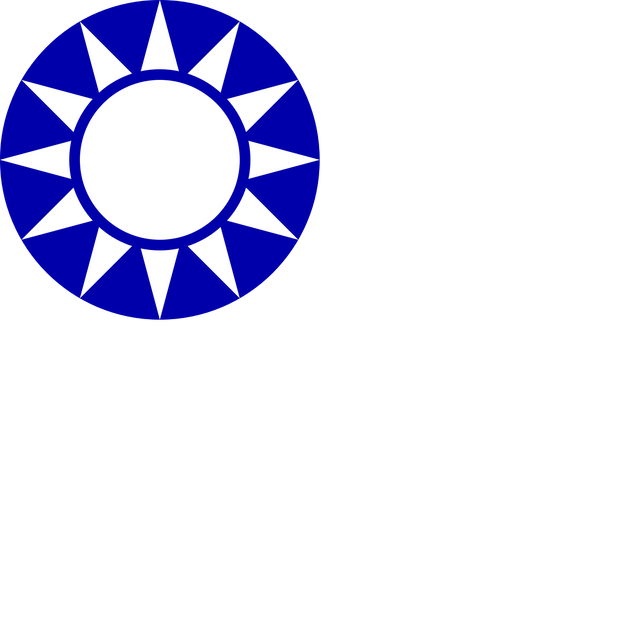
Kuomintang

Chinese Nationalist Party 中國國民黨 Zhōngguó Guómíndǎng | |||||||||||||||||||||||||||||||||||||||||
|---|---|---|---|---|---|---|---|---|---|---|---|---|---|---|---|---|---|---|---|---|---|---|---|---|---|---|---|---|---|---|---|---|---|---|---|---|---|---|---|---|---|
| Abbreviation | KMT | ||||||||||||||||||||||||||||||||||||||||
| Chairman | Wu Den-yih | ||||||||||||||||||||||||||||||||||||||||
| Secretary-General | Tseng Yung-chuan | ||||||||||||||||||||||||||||||||||||||||
| Founded | 10 October 1919 (1919-10-10) | ||||||||||||||||||||||||||||||||||||||||
| Preceded by |
| ||||||||||||||||||||||||||||||||||||||||
| Headquarters | 232–234 Sec 2 Bade Rd, Zhongshan District, Taipei, Taiwan, ROC 10492[1] | ||||||||||||||||||||||||||||||||||||||||
| Newspaper | |||||||||||||||||||||||||||||||||||||||||
| Think tank | National Policy Foundation [137] | ||||||||||||||||||||||||||||||||||||||||
| Youth wing | Kuomintang Youth League | ||||||||||||||||||||||||||||||||||||||||
| Membership (2018) | 1,090,000[2] | ||||||||||||||||||||||||||||||||||||||||
| Ideology | |||||||||||||||||||||||||||||||||||||||||
| Political position | Centre-right | ||||||||||||||||||||||||||||||||||||||||
| National affiliation | Pan-Blue Coalition | ||||||||||||||||||||||||||||||||||||||||
| International affiliation |
| ||||||||||||||||||||||||||||||||||||||||
| Colours | Blue | ||||||||||||||||||||||||||||||||||||||||
| Legislative Yuan | 34 / 113 | ||||||||||||||||||||||||||||||||||||||||
| Municipal Mayoralties | 3 / 6 | ||||||||||||||||||||||||||||||||||||||||
| City Mayoralties and County Magistracies | 12 / 16 | ||||||||||||||||||||||||||||||||||||||||
| Local Councillors | 394 / 912 | ||||||||||||||||||||||||||||||||||||||||
| Township Chiefs | 83 / 204 | ||||||||||||||||||||||||||||||||||||||||
| Party flag | |||||||||||||||||||||||||||||||||||||||||
 | |||||||||||||||||||||||||||||||||||||||||
| Website | |||||||||||||||||||||||||||||||||||||||||
| www.kmt.org.tw [138] | |||||||||||||||||||||||||||||||||||||||||
| |||||||||||||||||||||||||||||||||||||||||
| Kuomintang | |||||||||||||||||||||||||||||||||||||||||
 "Kuomintang (Guómíndǎng)" in Traditional (top) and Simplified (bottom) Chinese characters | |||||||||||||||||||||||||||||||||||||||||
| Chinese name | |||||||||||||||||||||||||||||||||||||||||
| Traditional Chinese | 中國國民黨 | ||||||||||||||||||||||||||||||||||||||||
| Simplified Chinese | 中国国民党 | ||||||||||||||||||||||||||||||||||||||||
| Literal meaning | "Nationals’ Party of China" | ||||||||||||||||||||||||||||||||||||||||
| |||||||||||||||||||||||||||||||||||||||||
| Abbreviated to | |||||||||||||||||||||||||||||||||||||||||
| Traditional Chinese | 國民黨 | ||||||||||||||||||||||||||||||||||||||||
| Simplified Chinese | 国民党 | ||||||||||||||||||||||||||||||||||||||||
| |||||||||||||||||||||||||||||||||||||||||
| Tibetan name | |||||||||||||||||||||||||||||||||||||||||
| Tibetan | ཀྲུང་གོའི་གོ་མིན་ཏང | ||||||||||||||||||||||||||||||||||||||||
| |||||||||||||||||||||||||||||||||||||||||
| Zhuang name | |||||||||||||||||||||||||||||||||||||||||
| Zhuang | Cunghgoz Gozminzdangj | ||||||||||||||||||||||||||||||||||||||||
| Mongolian name | |||||||||||||||||||||||||||||||||||||||||
| Mongolian Cyrillic | Дундадын (Хятадын) Гоминдан (Хувьсгалт Нам) | ||||||||||||||||||||||||||||||||||||||||
| Mongolian script | ᠳᠤᠮᠳᠠᠳᠤ ᠶᠢᠨ (ᠬᠢᠲᠠᠳ ᠤᠨ) ᠭᠣᠮᠢᠨᠳᠠᠩ (ᠬᠤᠪᠢᠰᠬᠠᠯᠲᠤ ᠨᠠᠮ) | ||||||||||||||||||||||||||||||||||||||||
| |||||||||||||||||||||||||||||||||||||||||
| Uyghur name | |||||||||||||||||||||||||||||||||||||||||
| Uyghur | جۇڭگو گومىنداڭ | ||||||||||||||||||||||||||||||||||||||||
| |||||||||||||||||||||||||||||||||||||||||
| Manchu name | |||||||||||||||||||||||||||||||||||||||||
| Manchu script | ᠵᡠᠩᡬᠣ ᡳ ᡬᠣᠮᡳᠨᡩᠠᠩ | ||||||||||||||||||||||||||||||||||||||||
| Romanization | Jungg'o-i G'omindang | ||||||||||||||||||||||||||||||||||||||||
The Kuomintang of China[9][10] (/ˈkwoʊˌmɪnˈtɑːŋ, -ˈtæŋ/,[11] KMT), also spelled as Guomindang and often alternatively translated as the Nationalist Party of China (NPC) or the Chinese Nationalist Party (CNP),[12] is a major political party in the Republic of China based in Taipei that was founded in 1911. The KMT was formerly the sole ruling party of the Republic of China from 1928 to 2000 and is currently an opposition political party in the Legislative Yuan.
The predecessor of the Kuomintang, the Revolutionary Alliance (Tongmenghui), was one of the major advocates of the overthrow of the Qing dynasty and the subsequent revolt in 1911 and proclamation of the Republic of China. The KMT was founded by Song Jiaoren and Sun Yat-sen shortly after the Xinhai Revolution of 1911. Sun was the provisional President, but he later ceded the presidency to Yuan Shikai. Later led by Chiang Kai-shek, the KMT formed the National Revolutionary Army and succeeded in its Northern Expedition to unify much of mainland China in 1928, ending the chaos of the Warlord Era. It was the ruling party in mainland China until 1949, when it lost the Chinese Civil War to the rival Communist Party of China. The KMT fled to Taiwan where it continued to govern as an authoritarian one-party state. This government retained China's United Nations seat (with considerable Western support) until 1971.
Taiwan ceased to be a single-party state in 1986 and political reforms beginning in the 1990s loosened the KMT's grip on power. Nevertheless, the KMT remains one of Taiwan's main political parties, with Ma Ying-jeou, elected in 2008 and re-elected in 2012, being the seventh KMT member to hold the office of the presidency. In the 2016 general and presidential election, the KMT was defeated in both elections and the Democratic Progressive Party (DPP) gained control of both the Legislative Yuan and the presidency, Tsai Ing-wen being elected President.
The party's guiding ideology is the Three Principles of the People, advocated by Sun Yat-sen. The KMT is a member of the International Democrat Union. Together with the People First Party and New Party, the KMT forms what is known as the Taiwanese Pan-Blue Coalition which supports eventual unification with the mainland. However, the KMT has been forced to moderate its stance by advocating the political and legal status quo of modern Taiwan as political realities make the reunification of China unlikely. The KMT holds to the one-China policy in that it officially considers that there is only one China, but that the Republic of China rather than the People's Republic of China is its legitimate government under the 1992 Consensus. In order to ease tensions with the PRC, the KMT has since 2008 endorsed the Three Noes policy as defined by Ma Ying-jeou, namely no unification, no independence and no use of force.[13]
Chinese Nationalist Party 中國國民黨 Zhōngguó Guómíndǎng | |||||||||||||||||||||||||||||||||||||||||
|---|---|---|---|---|---|---|---|---|---|---|---|---|---|---|---|---|---|---|---|---|---|---|---|---|---|---|---|---|---|---|---|---|---|---|---|---|---|---|---|---|---|
| Abbreviation | KMT | ||||||||||||||||||||||||||||||||||||||||
| Chairman | Wu Den-yih | ||||||||||||||||||||||||||||||||||||||||
| Secretary-General | Tseng Yung-chuan | ||||||||||||||||||||||||||||||||||||||||
| Founded | 10 October 1919 (1919-10-10) | ||||||||||||||||||||||||||||||||||||||||
| Preceded by |
| ||||||||||||||||||||||||||||||||||||||||
| Headquarters | 232–234 Sec 2 Bade Rd, Zhongshan District, Taipei, Taiwan, ROC 10492[1] | ||||||||||||||||||||||||||||||||||||||||
| Newspaper | |||||||||||||||||||||||||||||||||||||||||
| Think tank | National Policy Foundation [137] | ||||||||||||||||||||||||||||||||||||||||
| Youth wing | Kuomintang Youth League | ||||||||||||||||||||||||||||||||||||||||
| Membership (2018) | 1,090,000[2] | ||||||||||||||||||||||||||||||||||||||||
| Ideology | |||||||||||||||||||||||||||||||||||||||||
| Political position | Centre-right | ||||||||||||||||||||||||||||||||||||||||
| National affiliation | Pan-Blue Coalition | ||||||||||||||||||||||||||||||||||||||||
| International affiliation |
| ||||||||||||||||||||||||||||||||||||||||
| Colours | Blue | ||||||||||||||||||||||||||||||||||||||||
| Legislative Yuan | 34 / 113 | ||||||||||||||||||||||||||||||||||||||||
| Municipal Mayoralties | 3 / 6 | ||||||||||||||||||||||||||||||||||||||||
| City Mayoralties and County Magistracies | 12 / 16 | ||||||||||||||||||||||||||||||||||||||||
| Local Councillors | 394 / 912 | ||||||||||||||||||||||||||||||||||||||||
| Township Chiefs | 83 / 204 | ||||||||||||||||||||||||||||||||||||||||
| Party flag | |||||||||||||||||||||||||||||||||||||||||
 | |||||||||||||||||||||||||||||||||||||||||
| Website | |||||||||||||||||||||||||||||||||||||||||
| www.kmt.org.tw [138] | |||||||||||||||||||||||||||||||||||||||||
| |||||||||||||||||||||||||||||||||||||||||
| Kuomintang | |||||||||||||||||||||||||||||||||||||||||
 "Kuomintang (Guómíndǎng)" in Traditional (top) and Simplified (bottom) Chinese characters | |||||||||||||||||||||||||||||||||||||||||
| Chinese name | |||||||||||||||||||||||||||||||||||||||||
| Traditional Chinese | 中國國民黨 | ||||||||||||||||||||||||||||||||||||||||
| Simplified Chinese | 中国国民党 | ||||||||||||||||||||||||||||||||||||||||
| Literal meaning | "Nationals’ Party of China" | ||||||||||||||||||||||||||||||||||||||||
| |||||||||||||||||||||||||||||||||||||||||
| Abbreviated to | |||||||||||||||||||||||||||||||||||||||||
| Traditional Chinese | 國民黨 | ||||||||||||||||||||||||||||||||||||||||
| Simplified Chinese | 国民党 | ||||||||||||||||||||||||||||||||||||||||
| |||||||||||||||||||||||||||||||||||||||||
| Tibetan name | |||||||||||||||||||||||||||||||||||||||||
| Tibetan | ཀྲུང་གོའི་གོ་མིན་ཏང | ||||||||||||||||||||||||||||||||||||||||
| |||||||||||||||||||||||||||||||||||||||||
| Zhuang name | |||||||||||||||||||||||||||||||||||||||||
| Zhuang | Cunghgoz Gozminzdangj | ||||||||||||||||||||||||||||||||||||||||
| Mongolian name | |||||||||||||||||||||||||||||||||||||||||
| Mongolian Cyrillic | Дундадын (Хятадын) Гоминдан (Хувьсгалт Нам) | ||||||||||||||||||||||||||||||||||||||||
| Mongolian script | ᠳᠤᠮᠳᠠᠳᠤ ᠶᠢᠨ (ᠬᠢᠲᠠᠳ ᠤᠨ) ᠭᠣᠮᠢᠨᠳᠠᠩ (ᠬᠤᠪᠢᠰᠬᠠᠯᠲᠤ ᠨᠠᠮ) | ||||||||||||||||||||||||||||||||||||||||
| |||||||||||||||||||||||||||||||||||||||||
| Uyghur name | |||||||||||||||||||||||||||||||||||||||||
| Uyghur | جۇڭگو گومىنداڭ | ||||||||||||||||||||||||||||||||||||||||
| |||||||||||||||||||||||||||||||||||||||||
| Manchu name | |||||||||||||||||||||||||||||||||||||||||
| Manchu script | ᠵᡠᠩᡬᠣ ᡳ ᡬᠣᠮᡳᠨᡩᠠᠩ | ||||||||||||||||||||||||||||||||||||||||
| Romanization | Jungg'o-i G'omindang | ||||||||||||||||||||||||||||||||||||||||
History
Founding and Sun Yat-sen era
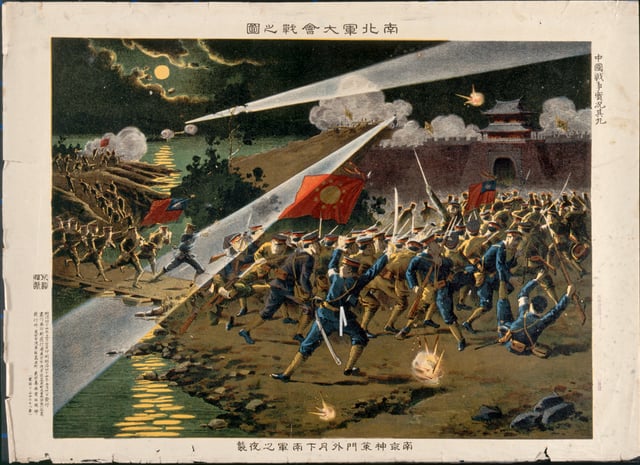
The Revolutionary Army attacking Nanjing in 1911
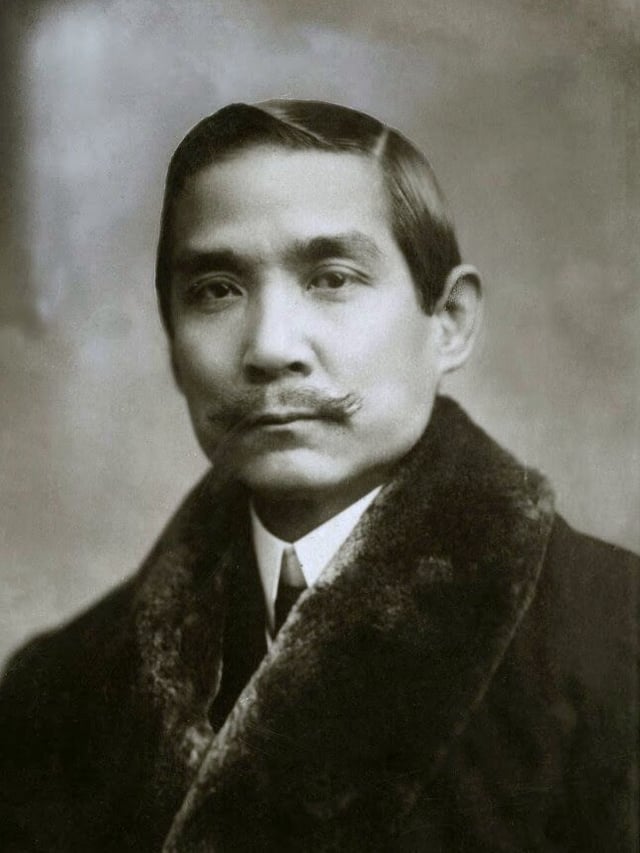
The KMT reveres its founder, Sun Yat-sen, as the "Father of the Nation"
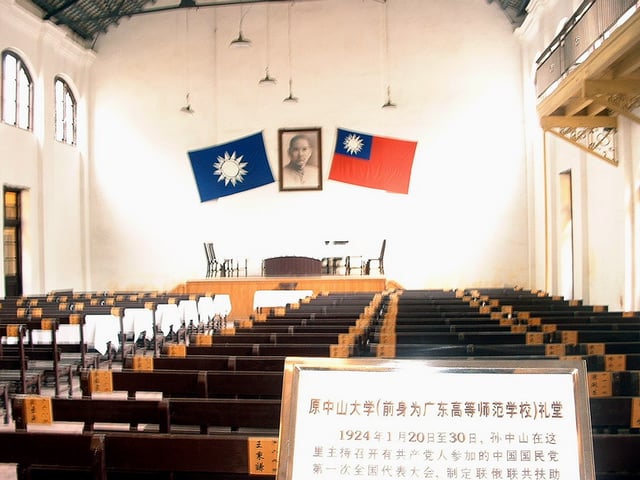
Venue of the 1st National Congress of Kuomintang in 1924
The KMT traces its ideological and organizational roots to the work of Sun Yat-sen, a proponent of Chinese nationalism and democracy who founded Revive China Society at the capital of the Republic of Hawaii, Honolulu on 24 November 1894.[14] In 1905, Sun joined forces with other anti-monarchist societies in Tokyo, Empire of Japan to form the Tongmenghui on 20 August 1905, a group committed to the overthrow of the Qing Dynasty and the establishment of a republic style government.
The group planned and supported the Xinhai Revolution of 1911 and the founding of the Republic of China on 1 January 1912. However, Sun did not have military power and ceded the provisional presidency of the republic to Yuan Shikai, who arranged for the abdication of Puyi, the last Emperor, on 12 February.
On 25 August 1912, the Nationalist Party was established at the Huguang Guild Hall in Peking, where Tongmenghui and five smaller pro-revolution parties merged to contest the first national elections.[15] Sun was chosen as the party chairman with Huang Xing as his deputy.
The most influential member of the party was the third ranking Song Jiaoren, who mobilized mass support from gentry and merchants for the Nationalists to advocate a constitutional parliamentary democracy. The party opposed constitutional monarchists and sought to check the power of Yuan. The Nationalists won an overwhelming majority of the first National Assembly election in December 1912.
However, Yuan soon began to ignore the parliament in making presidential decisions. Song Jiaoren was assassinated in Shanghai in 1913. Members of the Nationalists led by Sun Yat-sen suspected that Yuan was behind the plot and thus staged the Second Revolution in July 1913, a poorly planned and ill-supported armed rising to overthrow Yuan, and failed. Yuan, claiming subversiveness and betrayal, expelled adherents of the KMT from the parliament.[16][17] Yuan dissolved the Nationalists in November (whose members had largely fled into exile in Japan) and dismissed the parliament early in 1914.
Yuan Shikai proclaimed himself emperor in December 1915. While exiled in Japan in 1914, Sun established the Chinese Revolutionary Party on 8 July 1914, but many of his old revolutionary comrades, including Huang Xing, Wang Jingwei, Hu Hanmin and Chen Jiongming, refused to join him or support his efforts in inciting armed uprising against Yuan. In order to join the Revolutionary Party, members had to take an oath of personal loyalty to Sun, which many old revolutionaries regarded as undemocratic and contrary to the spirit of the revolution. As a result, he became largely sidelined within the Republican movement during this period.
Sun returned to China in 1917 to establish a military junta at Canton in order to oppose the Beiyang government, but was soon forced out of office and exiled to Shanghai. There, with renewed support, he resurrected the KMT on 10 October 1919, under the name Kuomintang of China (中國國民黨) and established its headquarters in Canton in 1920.
In 1923, the KMT and its Canton government accepted aid from the Soviet Union after being denied recognition by the western powers. Soviet advisers -- the most prominent of whom was Mikhail Borodin, an agent of the Comintern -- arrived in China in 1923 to aid in the reorganization and consolidation of the KMT along the lines of the Communist Party of the Soviet Union, establishing a Leninist party structure that lasted into the 1990s. The Communist Party of China (CPC) was under Comintern instructions to cooperate with the KMT, and its members were encouraged to join while maintaining their separate party identities, forming the First United Front between the two parties. Mao Zedong and early members of the CPC also joined the KMT in 1923.
Soviet advisers also helped the KMT to set up a political institute to train propagandists in mass mobilization techniques, and in 1923 Chiang Kai-shek, one of Sun's lieutenants from the Tongmenghui days, was sent to Moscow for several months' military and political study. At the first party congress in 1924 in Kwangchow, Kwangtung, (Guanzhou, Guangdong) which included non-KMT delegates such as members of the CPC, they adopted Sun's political theory, which included the Three Principles of the People - nationalism, democracy and people's livelihood.
Under Chiang Kai-shek in Mainland China
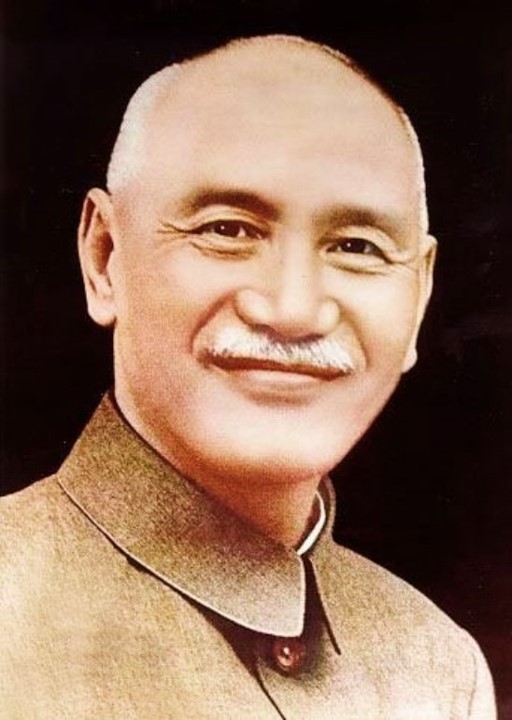
Chiang Kai-shek, leader of the Kuomintang after Sun's death in 1925
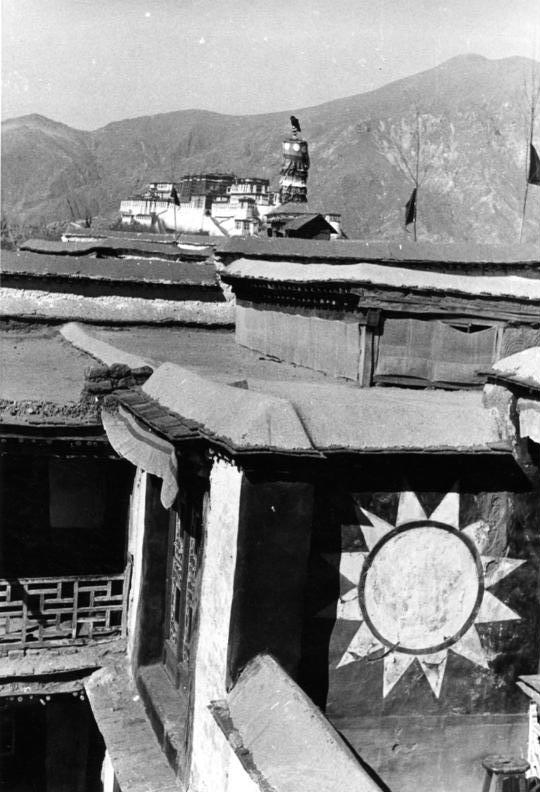
KMT flag displayed in Lhasa, Tibet in 1938
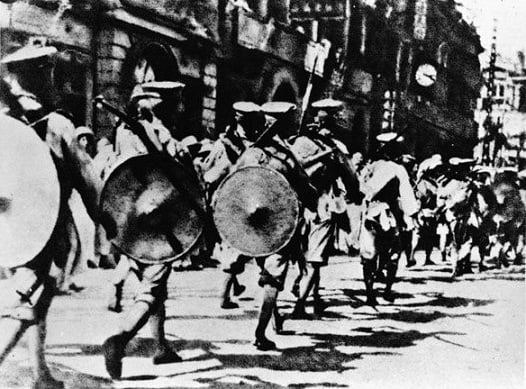
The National Revolutionary Army soldiers marched into the British concessions in Hankou during the Northern Expedition
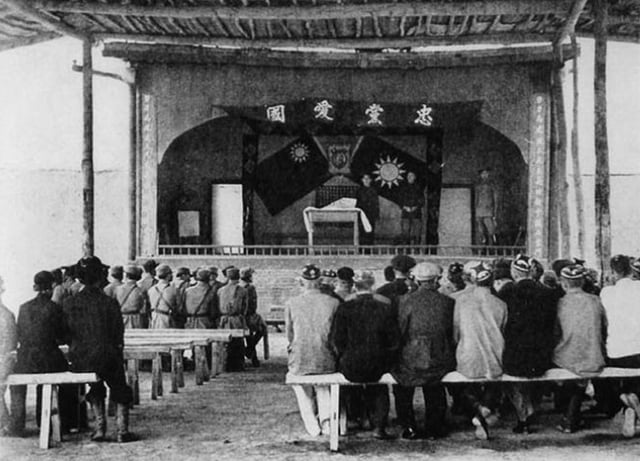
KMT in Tihwa, Sinkiang in 1942
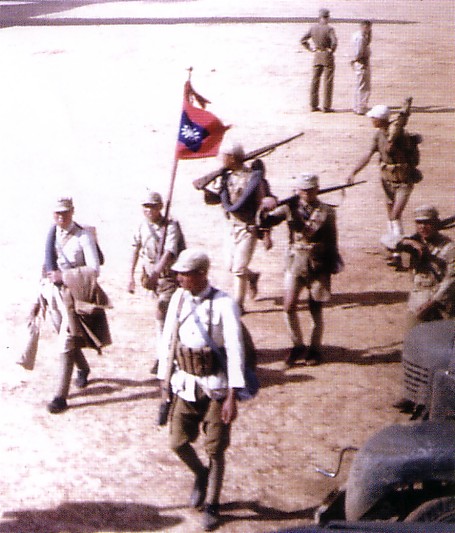
Nationalist soldiers during the Second Sino-Japanese War
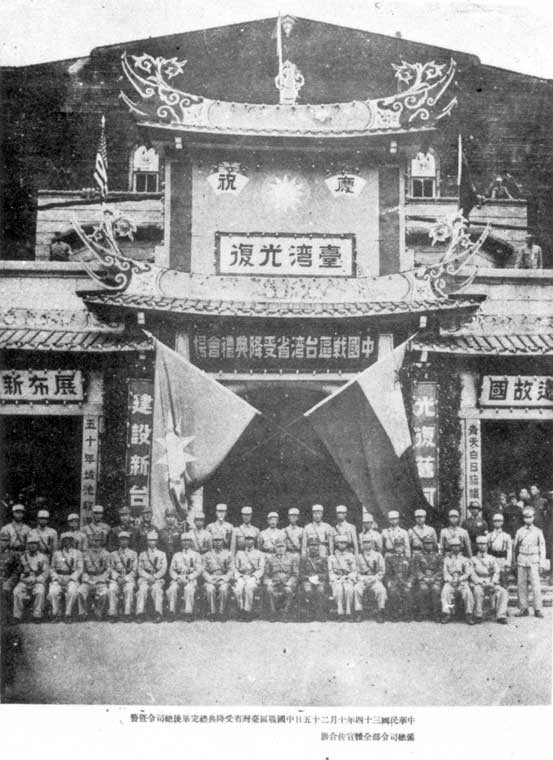
The retrocession of Taiwan in Taipei on 25 October 1945
When Sun Yat-sen died in 1925, the political leadership of the KMT fell to Wang Jingwei and Hu Hanmin, respectively the left-wing and right-wing leaders of the party. However, the real power was in the hands of Chiang Kai-shek, who was in near complete control of the military as the superintendent of the Whampoa Military Academy. With their military superiority, KMT confirmed their rule on Canton, the provincial capital of Kwangtung. The Guangxi warlords pledged loyalty to the KMT. The KMT now became a rival government in opposition to the warlord Beiyang government based in Peking.[18]
Chiang assumed leadership of the KMT on 6 July 1926. Unlike Sun Yat-sen, whom he admired greatly and who forged all his political, economic, and revolutionary ideas primarily from what he had learned in Hawaii and indirectly through British Hong Kong and Empire of Japan under Meiji Restoration, Chiang knew relatively little about the West. He also studied in Japan, but he was firmly rooted in his ancient Han Chinese identity and was steeped in Chinese culture. As his life progressed, he became increasingly attached to ancient Chinese culture and traditions. His few trips to the West confirmed his pro-ancient Chinese outlook and he studied the ancient Chinese classics and ancient Chinese history assiduously.[18] In 1924, Sun Yat-sen sent Chiang to spend three months in Moscow studying the political and military system of the Soviet Union. Chiang met Leon Trotsky and other Soviet leaders, but quickly came to the conclusion that the Soviet communist, Marxist and socialist model of government was not suitable for China. This laid the beginning of his lifelong antagonism against communism.
Chiang was also particularly committed to Sun's idea of "political tutelage". Sun believed that the only hope for a unified and better China lies in a military conquest, followed by a period of political tutelage that would culminate in the transition to democracy. Using this ideology, Chiang built himself into the dictator of the Republic of China, both in the Chinese mainland and when the national government was relocated to Taiwan.[18]
Following the death of Sun Yat-sen, Chiang Kai-shek emerged as the KMT leader and launched the Northern Expedition to defeat the northern warlords and unite China under the party. With its power confirmed in the southeast, the Nationalist Government appointed Chiang Kai-shek commander-in-chief of the National Revolutionary Army (NRA), and the Northern Expedition to suppress the warlords began. Chiang had to defeat three separate warlords and two independent armies. Chiang, with Soviet supplies, conquered the southern half of China in nine months.
A split erupted between the Chinese Communist Party and the KMT, which threatened the Northern Expedition. Wang Jing Wei, who led the KMT leftist allies, took the city of Wuhan in January 1927. With the support of the Soviet agent Mikhail Borodin, Wang declared the National Government as having moved to Wuhan. Having taken Nanking in March, Chiang halted his campaign and prepared a violent break with Wang and his communist allies. Chiang's expulsion of the CPC and their Soviet advisers, marked by the Shanghai massacre on April 12, led to the beginning of the Chinese Civil War. Wang finally surrendered his power to Chiang. Joseph Stalin ordered the Chinese Communist Party to obey the KMT leadership. Once this split had been healed, Chiang resumed his Northern Expedition and managed to take Shanghai.[18]
During the Nanking Incident in March 1927, the NRA stormed the consulates of the United States, United Kingdom (UK) and Empire of Japan, looted foreign properties and almost assassinated the Japanese consul. An American, two British, one French, an Italian and a Japanese were killed.[19] These looters also stormed and seized millions of dollars worth of British concessions in Hankou, refusing to hand them back to the UK.[20] Both Nationalists and Communist soldiers within the army participated in the rioting and looting of foreign residents in Nanking.[21]
NRA took Peking in 1928. The city was the internationally recognized capital, even when it was previously controlled by warlords. This event allowed the KMT to receive widespread diplomatic recognition in the same year. The capital was moved from Peking to Nanking, the original capital of the Ming Dynasty, and thus a symbolic purge of the final Qing elements. This period of KMT rule in China between 1927 and 1937 was relatively stable and prosperous and is still known as the Nanjing decade.
After the Northern Expedition in 1928, the Nationalist government under the KMT declared that China had been exploited for decades under the unequal treaties signed between the foreign powers and the Qing Dynasty. The KMT government demanded that the foreign powers renegotiate the treaties on equal terms.[22]
Before the Northern Expedition, the KMT began as a heterogeneous group advocating American-inspired federalism and provincial autonomy. However, the KMT under Chiang's leadership aimed at establishing a centralized one-party state with one ideology. This was even more evident following Sun's elevation into a cult figure after his death. The control by one single party began the period of "political tutelage", whereby the party was to lead the government while instructing the people on how to participate in a democratic system. The topic of reorganizing the army, brought up at a military conference in 1929, sparked the Central Plains War. The cliques, some of them former warlords, demanded to retain their army and political power within their own territories. Although Chiang finally won the war, the conflicts among the cliques would have a devastating effect on the survival of the KMT. Muslim Generals in Kansu waged war against the Guominjun in favor of the KMT during the conflict in Gansu in 1927-1930.[23]
Although the Second Sino-Japanese War officially broke out in 1937, Japanese aggression started in 1931 when they staged the Mukden Incident and occupied Manchuria. At the same time, the CPC had been secretly recruiting new members within the KMT government and military. Chiang was alarmed by the expansion of the communist influence. He believed that in order to fight against foreign aggression, the KMT must solve its internal conflicts first, so he started his second attempt to exterminate CPC members in 1934. With the advice from German military advisors, the KMT forced the Communists to withdraw from their bases in southern and central China into the mountains in a massive military retreat known as the Long March. Less than 10% of the communist army survived the long retreat to Shaanxi province, but they re-established their military base quickly with aid from the Soviet Union.
The KMT was also known to have used terror tactics against suspected communists, through the utilization of a secret police force, who were employed to maintain surveillance on suspected communists and political opponents. In The Birth of Communist China, C.P. Fitzgerald describes China under the rule of the KMT thus: "the Chinese people groaned under a regime Fascist in every quality except efficiency."[24]
Zhang Xueliang, who believed that the Japanese invasion was a greater threat, was persuaded by the CPC to take Chiang hostage during the Xi'an Incident in 1937 and forced Chiang to agree to an alliance with them in the total war against the Japanese. However, in many situations the alliance was in name only; after a brief period of cooperation, the armies began to fight the Japanese separately, rather than as coordinated allies. Conflicts between KMT and CPC were still common during the war, and documented claims abound of CPC attacks upon the KMT forces and vice versa.
While the KMT army received heavy casualties fighting the Japanese, the CPC expanded its territory by guerrilla tactics within Japanese occupied regions, leading some claims that the CPC often refused to support the KMT troops, choosing to withdraw and let the KMT troops take the brunt of Japanese attacks.[25]
After Japan surrendered in 1945, Taiwan was returned to the Republic of China on 25 October 1945. The brief period of celebration was soon shadowed by the possibility of a civil war between the KMT and CPC. The Soviet Union declared war on Japan just before it surrendered and occupied Manchuria, the north eastern part of China. The Soviet Union denied the KMT army the right to enter the region and allowed the CPC to take control of the Japanese factories and their supplies.
Full-scale civil war between the Communists and the Nationalists erupted in 1946. The Communist Chinese armies, the People's Liberation Army (PLA), previously a minor faction, grew rapidly in influence and power due to several errors on the KMT's part. First, the KMT reduced troop levels precipitously after the Japanese surrender, leaving large numbers of able-bodied, trained fighting men who became unemployed and disgruntled with the KMT as prime recruits for the PLA. Second, the KMT government proved thoroughly unable to manage the economy, allowing hyperinflation to result. Among the most despised and ineffective efforts it undertook to contain inflation was the conversion to the gold standard for the national treasury and the Gold Standard Scrip in August 1948, outlawing private ownership of gold, silver and foreign exchange, collecting all such precious metals and foreign exchange from the people and issuing the Gold Standard Scrip in exchange. As most farmland in the north were under CPC's control, the cities governed by the KMT lacked food supply and this added to the hyperinflation. The new scrip became worthless in only ten months and greatly reinforced the nationwide perception of the KMT as a corrupt or at best inept entity. Third, Chiang Kai-shek ordered his forces to defend the urbanized cities. This decision gave CPC a chance to move freely through the countryside. At first, the KMT had the edge with the aid of weapons and ammunition from the United States (US). However, with the country suffering from hyperinflation, widespread corruption and other economic ills, the KMT continued to lose popular support. Some leading officials and military leaders of the KMT hoarded material, armament and military-aid funding provided by the US. This became an issue which proved to be a hindrance of its relationship with US government. US President Harry S. Truman wrote that "the Chiangs, the Kungs and the Soongs (were) all thieves", having taken $750 million in US aid.[26]
At the same time, the suspension of American aid and tens of thousands of deserted or decommissioned soldiers being recruited to the PLA cause tipped the balance of power quickly to the CPC side, and the overwhelming popular support for the CPC in most of the country made it all but impossible for the KMT forces to carry out successful assaults against the Communists.
By the end of 1949, the CPC controlled almost all of mainland China, as the KMT retreated to Taiwan with a significant amount of China's national treasures and 2 million people, including military forces and refugees. Some party members stayed in the mainland and broke away from the main KMT to found the Revolutionary Committee of the Kuomintang, which still currently exists as one of the eight minor registered parties of the People's Republic of China.
In Taiwan since 1945

The former KMT headquarters in Taipei City (1949-2006), whose imposing structure, directly facing the Presidential Office Building, was seen as a symbol of the party's wealth and dominance
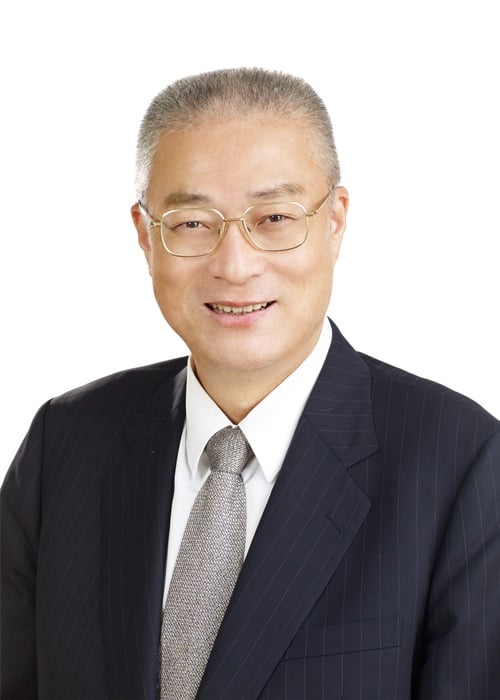
Wu Den-yih, the incumbent Chairperson of Kuomintang
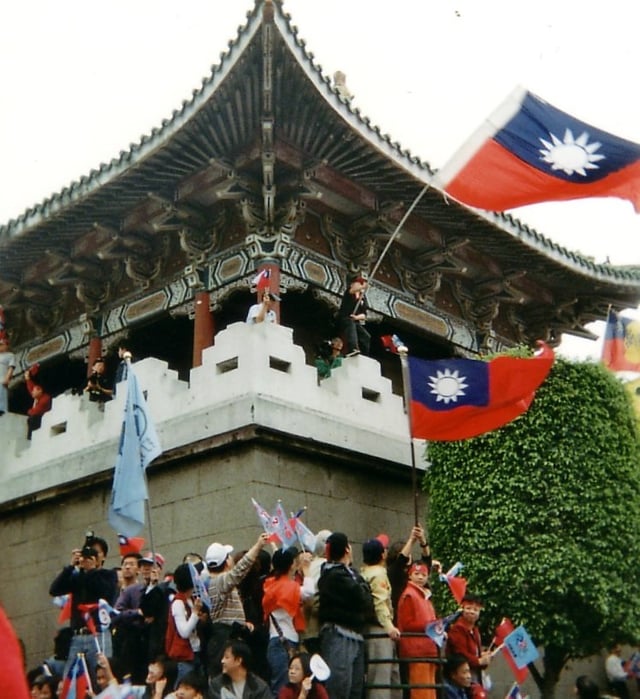
Pan-blue supporters at a rally during the 2004 presidential election
In 1895, Formosa (now called Taiwan), including the Penghu islands, became a Japanese colony via the Treaty of Shimonoseki following the First Sino-Japanese War.
After Japan's defeat at the end of World War II in 1945, General Order No. 1 instructed Japan to surrender its troops in Taiwan to Chiang Kai-shek. On 25 October 1945, KMT general Chen Yi acted on behalf of the Allied Powers to accept Japan's surrender and proclaimed that day as Taiwan Retrocession Day.
Tensions between the local Taiwanese and mainlanders from Mainland China increased in the intervening years, culminating in a flashpoint on 27 February 1947 in Taipei when a dispute between a female cigarette vendor and an anti-smuggling officer in front of Tianma Tea House triggered civil disorder and protests that would last for days. The uprising turned bloody and was shortly put down by the ROC Army in the February 28 Incident. As a result of the February 28 Incident in 1947, Taiwanese people endured what is called the "White Terror", a KMT-led political repression that resulted in the death or disappearance of over 30,000 Taiwanese intellectuals, activists, and people suspected of opposition to the KMT.[27]
Following the establishment of the People's Republic of China (PRC) on 1 October 1949, the commanders of the People's Liberation Army (PLA) believed that Kinmen and Matsu had to be taken before a final assault on Taiwan. The KMT fought the Battle of Guningtou on 25–27 October 1949 and stopped the PLA invasion. The KMT headquarter was set up on 10 December 1949 at No. 11 Zhongshan South Road.[28] In 1950, Chiang took office in Taipei under the Temporary Provisions Effective During the Period of Communist Rebellion. The provision declared martial law in Taiwan and halted some democratic processes, including presidential and parliamentary elections, until the mainland could be recovered from the CPC. The KMT estimated it would take 3 years to defeat the Communists. The slogan was "prepare in the first year, start fighting in the second, and conquer in the third year." Chiang also initiated the Project National Glory to retake back the mainland in 1965, but was eventually dropped in July 1972 after many unsuccessful attempts.
However, various factors, including international pressure, are believed to have prevented the KMT from militarily engaging the CPC full-scale. The KMT backed Muslim insurgents formerly belonging to the National Revolutionary Army during the KMT Islamic insurgency in 1950–1958 in Mainland China. A cold war with a couple of minor military conflicts was resulted in the early years. The various government bodies previously in Nanjing, that were re-established in Taipei as the KMT-controlled government, actively claimed sovereignty over all China. The Republic of China in Taiwan retained China's seat in the United Nations until 1971.
Until the 1970s, the KMT successfully pushed ahead with land reforms, developed the economy, implemented a democratic system in a lower level of the government, improved relations between Taiwan and the mainland and created the Taiwan economic miracle. However, the KMT controlled the government under a one-party authoritarian state until reforms in the late 1970s through the 1990s. The ROC in Taiwan was once referred to synonymously with the KMT and known simply as Nationalist China after its ruling party. In the 1970s, the KMT began to allow for "supplemental elections" in Taiwan to fill the seats of the aging representatives in the National Assembly.
Although opposition parties were not permitted, Tangwai ("outside the KMT") representatives were tolerated. In the 1980s, the KMT focused on transforming the government from a single-party system to a multi-party democratic one and embracing "Taiwanization". With the founding of the Democratic Progressive Party (DPP) on 28 September 1986, the KMT started competing against the DPP in Parliamentary elections.
In 1991, martial law ceased when President Lee Teng-hui terminated the Temporary Provisions Effective During the Period of Communist Rebellion. All parties started to be allowed to compete at all levels of elections, including the presidential election. Lee Teng-hui, the ROC's first democratically elected President and the leader of the KMT during the 1990s, announced his advocacy of "special state-to-state relations" with the PRC. The PRC associated this idea with Taiwan independence.
The KMT faced a split in 1993 that led to the formation of the New Party in August 1993, alleged to be a result of Lee's "corruptive ruling style". The New Party has, since the purging of Lee, largely reintegrated into the KMT. A much more serious split in the party occurred as a result of the 2000 Presidential election. Upset at the choice of Lien Chan as the party's presidential nominee, former party Secretary-General James Soong launched an independent bid, which resulted in the expulsion of Soong and his supporters and the formation of the People First Party (PFP) on 31 March 2000. The KMT candidate placed third behind Soong in the elections. After the election, Lee's strong relationship with the opponent became apparent. In order to prevent defections to the PFP, Lien moved the party away from Lee's pro-independence policies and became more favorable toward Chinese reunification. This shift led to Lee's expulsion from the party and the formation of the Taiwan Solidarity Union (TSU) by Lee supporters on 24 July 2001.
Prior to this, the party's voters had defected to both the PFP and TSU, and the KMT did poorly in the December 2001 legislative elections and lost its position as the largest party in the Legislative Yuan. However, the party did well in the 2002 local government mayoral and council election with Ma Ying-jeou, its candidate for Taipei mayor, winning reelection by a landslide and its candidate for Kaohsiung mayor narrowly losing but doing surprisingly well. Since 2002, the KMT and PFP have coordinated electoral strategies. In 2004, the KMT and PFP ran a joint presidential ticket, with Lien running for president and Soong running for vice-president.
The loss of the presidential election of 2004 to DPP President Chen Shui-bian by merely over 30,000 votes was a bitter disappointment to party members, leading to large scale rallies for several weeks protesting alleged electoral fraud and the "odd circumstances" of the shooting of President Chen. However, the fortunes of the party were greatly improved when the KMT did well in the legislative elections held in December 2004 by maintaining its support in southern Taiwan achieving a majority for the Pan-Blue Coalition.
Soon after the election, there appeared to be a falling out with the KMT's junior partner, the People First Party and talk of a merger seemed to have ended. This split appeared to widen in early 2005, as the leader of the PFP, James Soong appeared to be reconciling with President Chen Shui-Bian and the Democratic Progressive Party. Many PFP members including legislators and municipal leaders have defected to the KMT, and the PFP is seen as a fading party.
In 2005, Ma Ying-jeou became KMT chairman defeating speaker Wang Jin-pyng in the first public election for KMT chairmanship. The KMT won a decisive victory in the 3-in-1 local elections of December 2005, replacing the DPP as the largest party at the local level. This was seen as a major victory for the party ahead of legislative elections in 2007. There were elections for the two municipalities of the ROC, Taipei and Kaohsiung on December 2006. The KMT won a clear victory in Taipei, but lost to the DPP in the southern city of Kaohsiung by the slim margin of 1,100 votes.
On 13 February 2007, Ma was indicted by the Taiwan High Prosecutors Office on charges of allegedly embezzling approximately NT$11 million (US$339,000), regarding the issue of "special expenses" while he was mayor of Taipei. Shortly after the indictment, he submitted his resignation as KMT chairman at the same press conference at which he formally announced his candidacy for ROC President. Ma argued that it was customary for officials to use the special expense fund for personal expenses undertaken in the course of their official duties. In December 2007, Ma was acquitted of all charges and immediately filed suit against the prosecutors. In 2008, the KMT won a landslide victory in the Republic of China Presidential Election on 22 March 2008. The KMT fielded former Taipei mayor and former KMT chairman Ma Ying-jeou to run against the DPP's Frank Hsieh. Ma won by a butt of 17% against Hsieh. Ma took office on 20 May 2008, with Vice-Presidential candidate Vincent Siew, and ended 8 years of the DPP presidency. The KMT also won a landslide victory in the 2008 legislative elections, winning 81 of 113 seats, or 71.7% of seats in the Legislative Yuan. These two elections gave the KMT firm control of both the executive and legislative yuans.
On 25 June 2009, President Ma launched his bid to regain KMT's leadership and registered as the sole candidate for the election of the KMT chairmanship. On July 26, Ma won 93.87% of the vote, becoming the new chairman of the KMT,[29] taking office on 17 October 2009. This officially allows Ma to be able to meet with Xi Jinping, the General Secretary of the Communist Party of China and other PRC delegates, as he is able to represent the KMT as leader of a Chinese political party, rather than as head-of-state of a political entity unrecognized by the PRC.[30]
On 29 November 2014, the KMT suffered a heavy loss in the local election to the DPP, winning only 6 municipalities and counties, down from 14 in the previous election in 2009 and 2010. Ma Ying-jeou subsequently resigned from the party chairmanship on 3 December and replaced by acting Chairman Wu Den-yih. Chairmanship election was held on 17 January 2015 and Eric Chu was elected to become the new chairman. He was inaugurated on 19 February.[31]
Current issues and challenges
Party assets
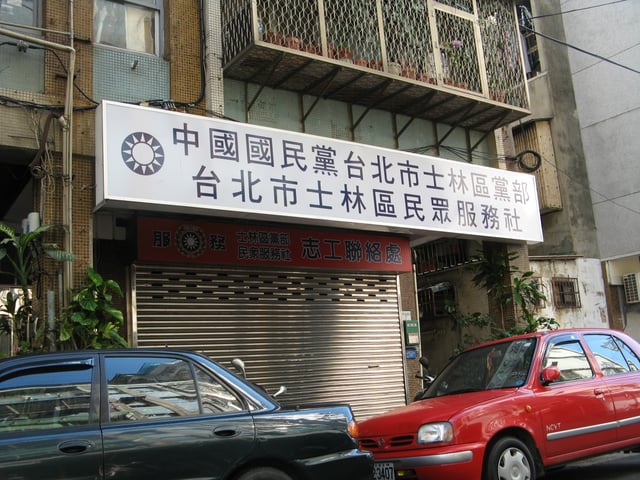
Kuomintang public service centre in Shilin, Taipei
As the ruling party on Taiwan, the KMT amassed a vast business empire of banks, investment companies, petrochemical firms, and television and radio stations, thought to have made it the world's richest political party, with assets once estimated to be around US$2–10 billion.[32] Although this war chest appeared to help the KMT until the mid-1990s, it later led to accusations of corruption (often referred to as "black gold").
After 2000, the KMT's financial holdings appeared to be more of a liability than a benefit, and the KMT started to divest itself of its assets. However, the transactions were not disclosed and the whereabouts of the money earned from selling assets (if it has gone anywhere) is unknown. There were accusations in the 2004 presidential election that the KMT retained assets that were illegally acquired. During the 2000-2008 DPP presidency, a law was proposed by the DPP in the Legislative Yuan to recover illegally acquired party assets and return them to the government. However, due to the DPP's lack of control of the legislative chamber at the time, it never materialised.
The KMT also acknowledged that part of its assets were acquired through extra-legal means and thus promised to "retro-endow" them to the government. However, the quantity of the assets which should be classified as illegal are still under heated debate. DPP, in its capacity as ruling party from 2000–2008, claimed that there is much more that the KMT has yet to acknowledge. Also, the KMT actively sold assets under its title in order to quench its recent financial difficulties, which the DPP argues is illegal. Former KMT Chairman Ma Ying-Jeou's position is that the KMT will sell some of its properties at below market rates rather than return them to the government and that the details of these transactions will not be publicly disclosed.
In July 2014, the KMT reported total assets of NT$26.8 billion (US$892.4 million) and interest earnings of NT$981.52 million for the year of 2013, making it one of the richest political parties in the world.[34]
In August 2016, the Ill-gotten Party Assets Settlement Committee is set up by the ruling DPP government to investigate KMT party assets acquired during the martial law period and recover those that were determined to be illegally acquired.[35]
Cross-strait relations

Lien Chan (middle) and Wu Po-hsiung (second left) and the KMT touring the Sun Yat-sen Mausoleum in Nanjing, People's Republic of China when the Pan-Blue coalition visited the mainland in 2005
In December 2003, then-KMT chairman (present chairman emeritus) and presidential candidate Lien Chan initiated what appeared to some to be a major shift in the party's position on the linked questions of Chinese reunification and Taiwan independence. Speaking to foreign journalists, Lien said that while the KMT was opposed to "immediate independence", it did not wish to be classed as "pro-reunificationist" either.
At the same time, Wang Jin-pyng, speaker of the Legislative Yuan and the Pan-Blue Coalition's campaign manager in the 2004 presidential election, said that the party no longer opposed Taiwan's "eventual independence". This statement was later clarified as meaning that the KMT opposes any immediate decision on unification and independence and would like to have this issue resolved by future generations. The KMT's position on the cross-strait relations was redefined as hoping to remain in the current neither-independent-nor-united situation.
However, there had been a warming of relations between the Pan-Blue Coalition and the PRC, with prominent members of both the KMT and PFP in active discussions with officials on the mainland. In February 2004, it appeared that KMT had opened a campaign office for the Lien-Soong ticket in Shanghai targeting Taiwanese businessmen. However, after an adverse reaction in Taiwan, the KMT quickly declared that the office was opened without official knowledge or authorization. In addition, the PRC issued a statement forbidding open campaigning in the mainland and formally stated that it had no preference as to which candidate won and cared only about the positions of the winning candidate.
In 2005, then-party chairman Lien Chan announced that he was to leave his office. The two leading contenders for the position included Ma Ying-jeou and Wang Jin-pyng. On 5 April 2005, Taipei Mayor Ma Ying-jeou said he wished to lead the opposition KMT with Wang Jin-pyng. On 16 July 2005, Ma was elected as KMT Chairman in the first contested leadership in KMT's 93-year history. Some 54% of the party's 1.04 million members cast their ballots. Ma garnered 72.4% of vote share, or 375,056 votes, against Wang's 27.6%, or 143,268 votes. After failing to convince Wang to stay on as a vice chairman, Ma named holdovers Wu Po-hsiung, Chiang Pin-kung and Lin Cheng-chi (林澄枝), as well as long-time party administrator and strategist John Kuan as vice-chairmen. All appointments were approved by a hand count of party delegates.
On 28 March 2005, thirty members of the KMT, led by Vice Chairman Chiang Pin-kung, arrived in mainland China. This marked the first official visit by the KMT to the mainland since it was defeated by communist forces in 1949 (although KMT members including Chiang had made individual visits in the past). The delegates began their itinerary by paying homage to the revolutionary martyrs of the Tenth Uprising at Huanghuagang. They subsequently flew to the former ROC capital of Nanjing to commemorate Sun Yat-sen. During the trip, the KMT signed a 10-points agreement with the CPC. The opponents regarded this visit as the prelude of the third KMT-CPC cooperation, after the First and Second United Front. Weeks afterwards, in May 2005, Chairman Lien Chan visited the mainland and met with Hu Jintao, General Secretary of the Communist Party of China. This marked the first meeting between leaders of the KMT and CPC after the end of Chinese Civil War in 1949. No agreements were signed because incumbent Chen Shui-bian's government threatened to prosecute the KMT delegation for treason and violation of ROC laws prohibiting citizens from collaborating with CPC.
Supporter base
Support for the KMT in Taiwan encompasses a wide range of groups. KMT support tends to be higher in northern Taiwan and in urban areas, where it draws its backing from big businesses due to its policy of maintaining commercial links with mainland China.
The KMT also has strong support in the labor sector because of the many labor benefits and insurance implemented while the KMT was in power. The KMT traditionally has strong cooperation with military officers, teachers, and government workers. Among the ethnic groups in Taiwan, the KMT has solid support among mainlanders and their descendants, for ideological reasons, and among Taiwanese aboriginals.
The deep-rooted hostility between Aboriginals and (Taiwanese) Hoklo, and the Aboriginal communities effective KMT networks, contribute to Aboriginal skepticism towards the Democratic Progressive Party (DPP) and the Aboriginals' tendency to vote for the KMT.[36] Aboriginals have criticized politicians for abusing the "indigenization" movement for political gains, such as aboriginal opposition to the DPP's "rectification" by recognizing the Taroko for political reasons, with the majority of mountain townships voting for Ma Ying-jeou.[37] In 2005 the Kuomintang displayed a massive photo of the anti-Japanese Aboriginal leader Mona Rudao at its headquarters in honor of the 60th anniversary of Taiwan's retrocession from Japan to the Republic of China.[38]
Traditional opponents of the KMT included strong supporters of Taiwan independence and rural residents, particularly in southern Taiwan.
For social issues, the KMT does not take an official position on same-sex marriage, though opposition to same-sex marriage comes mostly from Christian groups, who wield significant political influence especially within the KMT.[39]
Organization
Leadership
The Kuomintang's constitution designated Sun Yat-sen as party president. After his death, the Kuomintang opted to keep that language in its constitution to honor his memory forever. The party has since been headed by a director-general (1927–1975) and a chairman (since 1975), positions which officially discharge the functions of the president.
Chairman and Vice Chairmen
- Chairman
Current Chairman: Wu Den-yih (since 20 August 2017)
- Vice Chairpersons
Current Vice Chairpersons: Hau Lung-pin, Tseng Yung-chuan (since 20 August 2017)
Secretary-General and Vice Secretaries-General
- Secretary-General
Current Secretary-General: Tseng Yung-chuan (since 20 August 2017)
- Vice Secretaries-General
Current Vice Secretaries-General: Tu Chien-te (杜建德), Lin Te-fu
Legislative Yuan leader (Caucus leader)
Hong Yuh-chin (1 February 1999 – 1 February 2004)
Tseng Yung-chuan (1 February 2004 – 1 December 2008)
Lin Yi-shih (1 December 2008 – 1 February 2012)
Lin Hung-chih (1 February 2012 – 31 July 2014)
Alex Fai (31 July 2014 – 7 February 2015)
Lai Shyh-bao (7 February 2015 – 7 July 2016)
Liao Kuo-tung (7 July 2016 – 29 June 2017)
Lin Te-fu (29 June 2017 – 14 June 2018)
Johnny Chiang (since 14 June 2018)
Party organization and structure
The KMT is organised as such:[40]
National Congress Party Chairman Vice-Chairmen Central Committee Central Steering Committee for Women Central Standing Committee Secretary-General Deputy Secretaries-General Executive Director Policy Committee Policy Coordination Department Policy Research Department Mainland Affairs Department National Development Institute Administrative Division Research Division Education and Counselling Division Party Disciplinary Committee Evaluation and Control Office Audit Office Culture and Communications Committee Cultural Department Communications Department KMT Party History Institute Administration Committee Personnel Office General Office Finance Office Accounting Office Information Center Organizational Development Committee Organization and Operations Department Elections Mobilization Department Community Volunteers Department Overseas Department Youth Department Women's Department
Ideology in mainland China
Chinese nationalism
The KMT was a nationalist revolutionary party which had been supported by the Soviet Union. It was organized on the Leninist principle of organisation, democratic centralism.[41]
The KMT had several influences upon its ideology by revolutionary thinking. The KMT and Chiang Kai-shek used the words feudal and counterrevolutionary as synonyms for evil and backwardness, and they proudly proclaimed themselves to be revolutionaries.[42][43] Chiang called the warlords feudalists, and he also called for feudalism and counterrevolutionaries to be stamped out by the KMT.[44][45][46][47] Chiang showed extreme rage when he was called a warlord, because of the words negative and feudal connotations.[48] Ma Bufang was forced to defend himself against the accusations, and stated to the news media that his army was a part of "National army, people's power".[49]
Chiang Kai-shek, the head of the KMT, warned the Soviet Union and other foreign countries about interfering in Chinese affairs. He was personally angry at the way China was treated by foreigners, mainly by the Soviet Union, Britain, and the United States.[45][50] He and his New Life Movement called for the crushing of Soviet, Western, American and other foreign influences in China. Chen Lifu, a CC Clique member in the KMT, said "Communism originated from Soviet imperialism, which has encroached on our country." It was also noted that "the white bear of the North Pole is known for its viciousness and cruelty".[47]
The Blue Shirts Society, a fascist paramilitary organization within the KMT that modeled itself after Mussolini's blackshirts, was anti-foreign and anti-communist, and it stated that its agenda was to expel foreign (Japanese and Western) imperialists from China, crush Communism, and eliminate feudalism.[51] In addition to being anticommunist, some KMT members, like Chiang Kai-shek's right-hand man Dai Li were anti-American, and wanted to expel American influence.[52]
KMT leaders across China adopted nationalist rhetoric. The Chinese Muslim general Ma Bufang of Qinghai presented himself as a Chinese nationalist to the people of China, fighting against British imperialism, to deflect criticism by opponents that his government was feudal and oppressed minorities like Tibetans and Buddhist Mongols. He used his Chinese nationalist credentials to his advantage to keep himself in power.[53][54]
The KMT pursued a sinicization policy, it was stated that "the time had come to set about the business of making all natives either turn Chinese or get out" by foreign observers of KMT policy. It was noted that "Chinese colonization" of "Mongolia and Manchuria" led "to a conviction that the day of the barbarian was finally over".[55][56][57]
New Guangxi Clique
KMT branch in Guangxi province, led by the New Guangxi Clique of Bai Chongxi and Li Zongren, implemented anti-imperialist, anti-religious, and anti-foreign policies. During the Northern Expedition, in 1926 in Guangxi, Muslim General Bai Chongxi led his troops in destroying most of the Buddhist temples and smashing idols, turning the temples into schools and KMT headquarters. Bai led an anti-foreign wave in Guangxi, attacking American, European, and other foreigners and missionaries, and generally making the province unsafe for non-natives. Westerners fled from the province, and some Chinese Christians were also attacked as imperialist agents.[58]
The leaders clashed with Chiang Kai-shek, which led to the Central Plains War where Chiang defeated the clique.
Socialism and anti-capitalist agitation
KMT had a left wing and a right wing, the left being more radical in its pro-Soviet policies, but both wings equally persecuted merchants, accusing them of being counterrevolutionaries and reactionaries. The right wing under Chiang Kai-shek prevailed, and continued radical policies against private merchants and industrialists, even as they denounced communism.
One of the Three Principles of the People of KMT, Mínshēng, was defined as socialism by Dr. Sun Yat-sen. He defined this principle of saying in his last days "its socialism and its communism". The concept may be understood as social welfare as well. Sun understood it as an industrial economy and equality of land holdings for the Chinese peasant farmers. Here he was influenced by the American thinker Henry George (see Georgism) and German thinker Karl Marx; the land value tax in Taiwan is a legacy thereof. He divided livelihood into four areas: food, clothing, housing, and transportation; and planned out how an ideal (Chinese) government can take care of these for its people.
KMT was referred to having a socialist ideology. "Equalization of land rights" was a clause included by Dr. Sun in the original Tongmenhui. KMT's revolutionary ideology in the 1920s incorporated unique Chinese Socialism as part of its ideology.[59]
The Soviet Union trained KMT revolutionaries in the Moscow Sun Yat-sen University. In the West and in the Soviet Union, Chiang was known as the "Red General".[60] Movie theaters in the Soviet Union showed newsreels and clips of Chiang, at Moscow Sun Yat-sen University Portraits of Chiang were hung on the walls, and in the Soviet May Day Parades that year, Chiang's portrait was to be carried along with the portraits of Karl Marx, Lenin, Stalin, and other socialist leaders.[61]
KMT attempted to levy taxes upon merchants in Canton, and the merchants resisted by raising an army, the Merchant's volunteer corps. Dr. Sun initiated this anti-merchant policy, and Chiang Kai-shek enforced it, Chiang led his army of Whampoa Military Academy graduates to defeat the merchant's army. Chiang was assisted by Soviet advisors, who supplied him with weapons, while the merchants were supplied with weapons from the Western countries.[62][63]
KMT were accused of leading a "Red Revolution" in Canton. The merchants were conservative and reactionary, and their Volunteer Corp leader Chen Lianbao was a prominent comprador trader.[62]
The merchants were supported by the foreign, western Imperialists such as the British, who led an international flotilla to support them against Dr. Sun.[63] Chiang seized the western supplied weapons from the merchants, and battled against them. A KMT General executed several merchants, and KMT formed a Soviet inspired Revolutionary Committee.[64] The British Communist party congratulated Dr. Sun for his war against foreign imperialists and capitalists.[65]
In 1948, KMT again attacked the merchants of Shanghai, Chiang Kai-shek sent his son Chiang Ching-kuo to restore economic order. Ching-kuo copied Soviet methods, which he learned during his stay there, to start a social revolution by attacking middle-class merchants. He also enforced low prices on all goods to raise support from the proletariat.[66]
As riots broke out and savings were ruined, bankrupting shop owners, Ching-kuo began to attack the wealthy, seizing assets and placing them under arrest. The son of the gangster Du Yuesheng was arrested by him. Ching-kuo ordered KMT agents to raid the Yangtze Development Corporation's warehouses, which was privately owned by H.H. Kung and his family. H.H. Kung's wife was Soong Ai-ling, the sister of Soong Mei-ling who was Ching-kuo's stepmother. H.H. Kung's son David was arrested, the Kung's responded by blackmailing the Chiang's, threatening to release information about them, eventually he was freed after negotiations, and Ching-kuo resigned, ending the terror on the Shanghainese merchants.[67]
KMT also promotes government-owned corporations. KMT founder Sun Yat-sen, was heavily influenced by the economic ideas of Henry George, who believed that the rents extracted from natural monopolies or the usage of land belonged to the public. Dr. Sun argued for Georgism and emphasized the importance of a mixed economy, which he termed "The Principle of Minsheng" in his Three Principles of the People.
"The railroads, public utilities, canals, and forests should be nationalized, and all income from the land and mines should be in the hands of the State. With this money in hand, the State can therefore finance the social welfare programs."[68]
KMT Muslim Governor of Ningxia, Ma Hongkui promoted state-owned monopolies. His government had a company, Fu Ning Company, which had a monopoly over commerce and industry in Ningxia.[69]
Corporations such as CSBC Corporation, Taiwan, CPC Corporation, Taiwan and Aerospace Industrial Development Corporation are owned by the state in the Republic of China.
Marxists also existed in KMT. They viewed the Chinese revolution in different terms than the CPC, claiming that China already went past its feudal stage and in a stagnation period rather than in another mode of production. These Marxists in KMT opposed the CPC ideology.[70]
Confucianism and religion in its ideology

From left to right, KMT members pay tribute to the Sun Yat-sen Mausoleum in Beijing in 1928 after the success of the Northern Expedition: Generals Cheng Jin, Zhang Zuobao, Chen Diaoyuan, Chiang Kai-shek, Woo Tsin-hang, Yan Xishan, General Ma Fuxiang, Ma Sida and General Bai Chongxi
The KMT backed the New Life Movement, which promoted Confucianism, and it was also against westernization. KMT leaders also opposed the May Fourth Movement. Chiang Kai-shek, as a nationalist, and Confucianist, was against the iconoclasm of the May Fourth Movement. He viewed some western ideas as foreign, as a Chinese nationalist, and that the introduction of western ideas and literature that the May Fourth Movement wanted was not welcome. He and Dr. Sun Yat-sen criticized these May Fourth intellectuals for corrupting morals of youth.[75]
KMT also incorporated Confucianism in its jurisprudence. It pardoned Shi Jianqiao for murdering Sun Chuanfang, because she did it in revenge since Sun executed her father Shi Congbin, which was an example of Filial piety to one's parents in Confucianism.[76] KMT encouraged filial revenge killings and extended pardons to those who performed them.[77]
Education
KMT purged China's education system of Western ideas, introducing Confucianism into the curriculum. Education came under the total control of state, which meant, in effect, the KMT, via the Ministry of Education. Military and political classes on KMT's Three Principles of the People were added. Textbooks, exams, degrees and educational instructors were all controlled by the state, as were all universities.[78]
Soviet-style military
Chiang Ching-kuo, appointed as KMT director of Secret Police in 1950, was educated in the Soviet Union, and initiated Soviet style military organization in the Republic of China Military, reorganizing and Sovietizing the political officer corps, surveillance, and KMT activities were propagated throughout the military. Opposed to this was Sun Li-jen, who was educated at the American Virginia Military Institute.[79] Chiang Ching-kuo then arrested Sun Li-jen, charging him of conspiring with the American CIA of plotting to overthrow Chiang Kai-shek and KMT, Sun was placed under house arrest in 1955.[80][81]
Parties affiliated with the Kuomintang
Malaysian Chinese Association

Malaysian Chinese Association
The Malaysian Chinese Association (MCA) was initially pro-ROC and mainly consisted of KMT members who joined as an alternative and were also in opposition to the Malayan Communist Party, supporting the KMT in China by funding them with the intention of reclaiming the Chinese mainland from the communists.[82]
Tibet Improvement Party
The Tibet Improvement Party was founded by Pandatsang Rapga, a pro-ROC and pro-KMT Khampa revolutionary, who worked against the 14th Dalai Lama's Tibetan Government in Lhasa. Rapga borrowed Sun Yat-sen's Three Principles of the People doctrine and translated his political theories into the Tibetan language, hailing it as the best hope for Asian peoples against imperialism. Rapga stated that "the Sanmin Zhuyi was intended for all peoples under the domination of foreigners, for all those who had been deprived of the rights of man. But it was conceived especially for the Asians. It is for this reason that I translated it. At that time, a lot of new ideas were spreading in Tibet," during an interview in 1975 by Dr. Heather Stoddard.[83] He wanted to destroy the feudal government in Lhasa, in addition to modernizing and secularizing Tibetan society. The ultimate goal of the party was the overthrow of the Dalai Lama's regime, and the creation of a Tibetan Republic which would be an autonomous Republic within the ROC.[84] Chiang Kai-shek and the KMT funded the party and their efforts to build an army to battle the Dalai Lama's government.[85] KMT was extensively involved in the Kham region, recruiting the Khampa people to both oppose the Dalai Lama's Tibetan government, fight the Communist Red Army, and crush the influence of local Chinese warlords who did not obey the central government.
Vietnamese Nationalist Party

Vietnamese Kuomintang

People's Action Party of Vietnam
The KMT assisted the Viet Nam Quoc Dan Dang party which translates literally into Chinese (越南國民黨; Yuènán Guómíndǎng) as the Vietnamese Nationalist Party.[86][87] When it was established, it was based on the Chinese KMT and was pro Chinese.[88][89] The Chinese KMT helped the party, known as the VNQDD, set up headquarters in Canton and Yunnan, to aid their anti imperialist struggle against the French occupiers of Indo China and against the Vietnamese Communist Party. It was the first revolutionary nationalist party to be established in Vietnam, before the communist party. The KMT assisted VNQDD with funds and military training.
The VNQDD was founded with KMT aid in 1925, they were against Ho Chi Minh's Viet Nam Revolutionary Youth League. [90] When the VNQDD fled to China after the failed uprising against the French, they settled in Yunnan and Canton, in two different branches. [91] [92] The VNQDD existed as a party in exile in China for 15 years, receiving help, militarily and financially, and organizationally from the Chinese KMT.[93] The two VNQDD parties merged into a single organization, the Canton branch removed the word "revolutionary" from the party name. Lu Han, a KMT official in Nanjing, who was originally from Yunnan, was contacted by the VNQDD, and the KMT Central Executive Committee and Military made direct contact with VNQDD for the first time, the party was reestablished in Nanjing with KMT help. [90]
The Chinese KMT used the VNQDD for its own interests in south China and Indo China. General Zhang Fakui (Chang Fa-kuei), who based himself in Guangxi, established the Viet Nam Cach Menh Dong Minh Hoi meaning "Viet Nam Revolutionary League" in 1942, which was assisted by the VNQDD to serve the KMT's aims. The Chinese Yunnan provincial army, under the KMT, occupied northern Vietnam after the Japanese surrender in 1945, the VNQDD tagging alone, opposing Ho Chi Minh's communist party.[94] The Viet Nam Revolutionary League was a union of various Vietnamese nationalist groups, run by the pro Chinese VNQDD. Its stated goal was for unity with China under the Three Principles of the People, created by KMT founder Dr. Sun and opposition to Japanese and French Imperialists.[95][96] The Revolutionary League was controlled by Nguyen Hai Than, who was born in China and could not speak Vietnamese. General Zhang shrewdly blocked the Communists of Vietnam, and Ho Chi Minh from entering the league, as his main goal was Chinese influence in Indo China.[97] The KMT utilized these Vietnamese nationalists during World War II against Japanese forces.[98]
A KMT left-winger, General Chang Fa-kuei worked with Nguyen Hai Than, a VNQDD member, against French Imperialists and Communists in Indo China.[99] General Chang Fa-kuei planned to lead a Chinese army invasion of Tonkin in Indochina to free Vietnam from French control, and to get Chiang Kai-shek's support.[100] The VNQDD opposed the government of Ngo Dinh Diem during the Vietnam War.[101]
After the Fall of Saigon in 1977 the party dissolved and was refounded in 1991 as People's Action Party of Vietnam.
Ryukyu Guomindang
On 30 November 1958, the establishment of the Ryukyu Guomindang took place. Tsugumasa Kiyuna headed its predecessor party, the Ryukyuan separatist Ryukyu Revolutionary Party which was backed by the Kuomintang in Taiwan.[102]
Pro-Kuomintang camp
The Pro-Kuomintang camp is a political alignment in Hong Kong. It generally pledges allegiance to the Kuomintang.
One of these members, the 123 Democratic Alliance, dissolved in 2000 due to the lack of financial support from the Taiwan government, after the Presidential election.[103]
Organizations sponsored by the Kuomintang
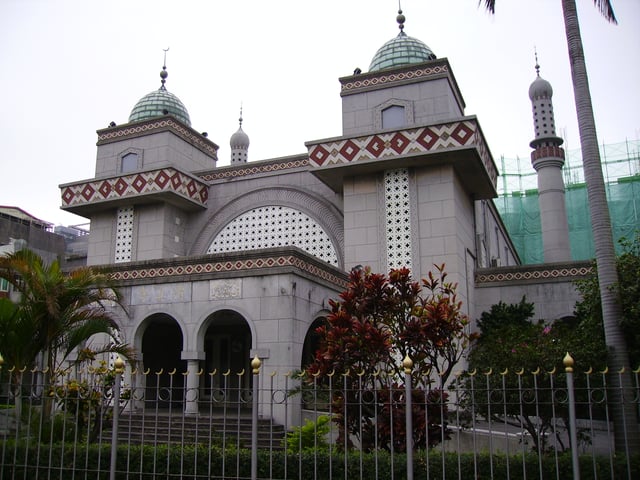
Taipei Grand Mosque
Ma Fuxiang founded Islamic organizations sponsored by KMT, including the China Islamic Association (中國回教公會).[104]
The Chinese Muslim Association was also sponsored by KMT, and it evacuated from the mainland to Taiwan with the party. The Chinese Muslim Association owns the Taipei Grand Mosque which was built with funds from KMT.[107]
The Yihewani (Ikhwan al Muslimun a.k.a. Muslim brotherhood) was the predominant Muslim sect backed by KMT. Other Muslim sects, like the Xidaotang were also supported by the KMT. The Chinese Muslim brotherhood became a Chinese nationalist organization and supported KMT rule. Brotherhood Imams like Hu Songshan ordered Muslims to pray for the Nationalist Government, salute KMT flags during prayer, and listen to nationalist sermons.
Policy on ethnic minorities
KMT considers all minorities to be members of the Chinese nation. Former KMT leader Chiang Kai-shek considered all the minority peoples of China, including the Hui, as descendants of Yellow Emperor, the Yellow Emperor and semi mythical founder of the Chinese nation. Chiang considered all the minorities to belong to the Chinese Nation Zhonghua Minzu and he introduced this into KMT ideology, which was propagated into the educational system of the Republic of China, and the Constitution of the ROC considered Chiang's ideology to be true.[108][109][110] In Taiwan, the President performs a ritual honoring the Yellow Emperor, while facing west, in the direction of the Chinese mainland.[111]
KMT kept the Mongolian and Tibetan Affairs Commission for dealing with Mongolian And Tibetan affairs. A Muslim, Ma Fuxiang, was appointed as its Chairman.[112]
KMT was known for sponsoring Muslim students to study abroad at Muslim universities like Al Azhar and it established schools especially for Muslims, Muslim KMT warlords like Ma Fuxiang promoted education for Muslims.[113] KMT Muslim Warlord Ma Bufang built a girls' school for Muslim girls in Linxia City which taught modern secular education.[114]
Tibetans and Mongols refused to allow other ethnic groups like Kazakhs to participate in the Kokonur ceremony in Qinghai, but the KMT Muslim General Ma Bufang allowed them to participate.[115]
KMT incited anti Yan Xishan and Feng Yuxiang sentiments among Chinese Muslims and Mongols, encouraging for them to topple their rule during the Central Plains War.[118]
Masud Sabri, a Uyghur was appointed as Governor of Xinjiang by KMT, as was the Tatar Burhan Shahidi and the Uyghur Yulbars Khan.[119]
The Muslim General Ma Bufang also put KMT symbols on his mansion, the Ma Bufang Mansion along with a portrait of party founder Dr. Sun Yatsen arranged with KMT flag and the Republic of China flag.
General Ma Bufang and other high ranking Muslim Generals attended the Kokonuur Lake Ceremony where the God of the Lake was worshipped, and during the ritual, the Chinese national anthem was sung, all participants bowed to a Portrait of KMT founder Dr. Sun Yat-sen, and the God of the Lake was also bowed to, and offerings were given to him by the participants, which included the Muslims.[120] This cult of personality around KMT leader and KMT was standard in all meetings. Sun Yat-sen's portrait was bowed to three times by KMT party members.[121] Dr. Sun's portrait was arranged with two flags crossed under, the KMT flag and the flag of the Republic of China.
KMT also hosted conferences of important Muslims like Bai Chongxi, Ma Fuxiang, and Ma Liang. Ma Bufang stressed "racial harmony" as a goal when he was Governor of Qinghai.[122]
In 1939, Isa Yusuf Alptekin and Ma Fuliang were sent on a mission by KMT to the Middle Eastern countries such as Egypt, Turkey and Syria to gain support for the Chinese War against Japan, they also visited Afghanistan in 1940 and contacted Muhammad Amin Bughra, they asked him to come to Chongqing, the capital of the Nationalist Government. Bughra was arrested by the British in 1942 for spying, and KMT arranged for Bughra's release. He and Isa Yusuf worked as editors of KMT Muslim publications.[123] Ma Tianying (馬天英) (1900–1982) led the 1939 mission which had 5 other people including Isa and Fuliang.[124]
Stance on separatism
KMT is anti-separatist. During its rule on mainland China, it crushed Uyghur and Tibetan separatist uprisings. KMT claims sovereignty over Mongolia and Tuva as well as the territories of the modern People's Republic and Republic of China.
KMT Muslim General Ma Bufang waged war on the invading Tibetans during the Sino-Tibetan War with his Muslim army, and he repeatedly crushed Tibetan revolts during bloody battles in Qinghai provinces. Ma Bufang was fully supported by President Chiang Kai-shek, who ordered him to prepare his Muslim army to invade Tibet several times and threatened aerial bombardment on the Tibetans. With support from KMT, Ma Bufang repeatedly attacked the Tibetan area of Golog seven times during the KMT Pacification of Qinghai, eliminating thousands of Tibetans.[125]
General Ma Fuxiang, the chairman of the Mongolian and Tibetan Affairs Commission stated that Mongolia and Tibet were an integral part of the Republic of China, arguing:
Our Party [the Guomindang] takes the development of the weak and small and resistance to the strong and violent as our sole and most urgent task. This is even more true for those groups which are not of our kind [Ch. fei wo zulei zhe]. Now the people of Mongolia and Tibet are closely related to us, and we have great affection for one another: our common existence and common honor already have a history of over a thousand years. [...] Mongolia and Tibet's life and death are China's life and death. China absolutely cannot cause Mongolia and Tibet to break away from China's territory, and Mongolia and Tibet cannot reject China to become independent. At this time, there is not a single nation on earth except China that will sincerely develop Mongolia and Tibet.[126]
Under orders from Nationalist Government of Chiang Kai-shek, the Hui General Ma Bufang, Governor of Qinghai (1937–1949), repaired Yushu airport to prevent Tibetan separatists from seeking independence. Ma Bufang also crushed Mongol separatist movements, abducting the Genghis Khan Shrine and attacking Tibetan Buddhist Temples like Labrang, and keeping a tight control over them through the Kokonur God ceremony.[120][127]
During the Kumul Rebellion, KMT 36th Division (National Revolutionary Army) crushed a separatist Uyghur First East Turkestan Republic, delivering it a fatal blow at the Battle of Kashgar (1934). The Muslim General Ma Hushan pledged allegiance to KMT and crushed another Uyghur revolt at Charkhlik Revolt.
During the Ili Rebellion, KMT fought against Uyghur separatists and the Soviet Union, and against Mongolia.
Election results
Presidential elections
Legislative elections
Local elections
| Election | Mayors Magistrates | Councils | Third-level Municipal heads | Third-level Municipal councils | Fourth-level Village heads | Election Leader |
|---|---|---|---|---|---|---|
| 1994 province-level only | 2 / 3 | 91 / 175 | N/A | N/A | N/A | Lee Teng-hui |
| 1997 | 8 / 23 | 522 / 886 | 236 / 319 | N/A | N/A | Lee Teng-hui |
| 1998 municipalities only | 1 / 2 | 48 / 96 | N/A | N/A | N/A | Lee Teng-hui |
| 2001 | 9 / 23 | 382 / 897 | 195 / 319 | N/A | N/A | Lien Chan |
| 2002 municipalities only | 1 / 2 | 32 / 96 | N/A | N/A | N/A | Lien Chan |
| 2005 | 14 / 23 | 408 / 901 | 173 / 319 | N/A | N/A | Ma Ying-jeou |
| 2006 municipalities only | 1 / 2 | 41 / 96 | N/A | N/A | N/A | Ma Ying-jeou |
| 2009 | 12 / 17 | 289 / 587 | 121 / 211 | N/A | N/A | Ma Ying-jeou |
| 2010 municipalities only | 3 / 5 | 130 / 314 | N/A | N/A | 1,195 / 3,757 | Ma Ying-jeou |
| 2014 unified | 6 / 22 | 291 / 906 | 54 / 204 | 194 / 2,137 | 390 / 7,836 | Ma Ying-jeou |
| 2018 unified | 15 / 22 | 394 / 912 | 84 / 204 | 390 / 2,148 | 1,220 / 7,744 | Wu Den-yih |
National Assembly elections
See also
Administrative divisions of the Republic of China
February 28 Incident
Campaign at the China–Burma border
Chinese nationalism
Conservatism in Taiwan
Elections in Taiwan
Index of Taiwan-related articles
History of the Kuomintang cultural policy
History of the Republic of China
Joseph Stilwell
KMT retreat to Taiwan in 1949
Kuomintang Islamic insurgency in China (1950–58)
Military of the Republic of China
National Revolutionary Army
Nationalist government
New Kuomintang Alliance
Political status of Taiwan
Politics of the Republic of China
Revolutionary Committee of the Chinese Kuomintang
Outline of Taiwan
Whampoa Military Academy
White Terror (Taiwan)